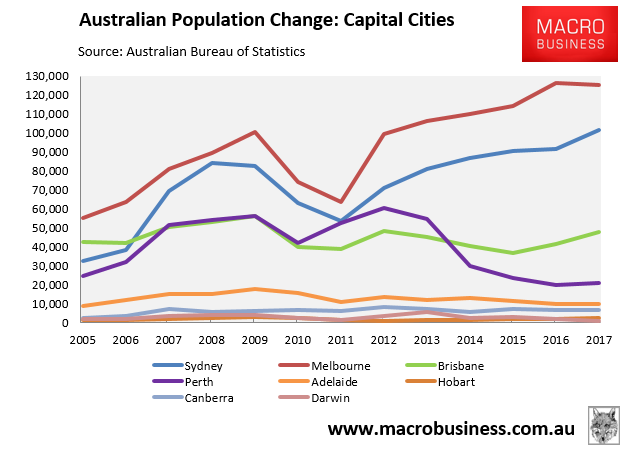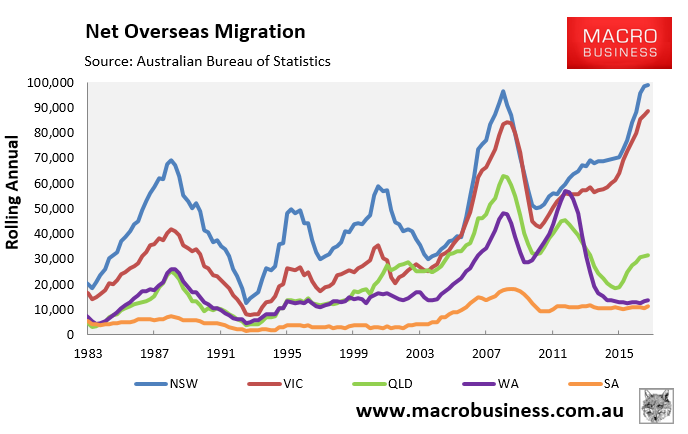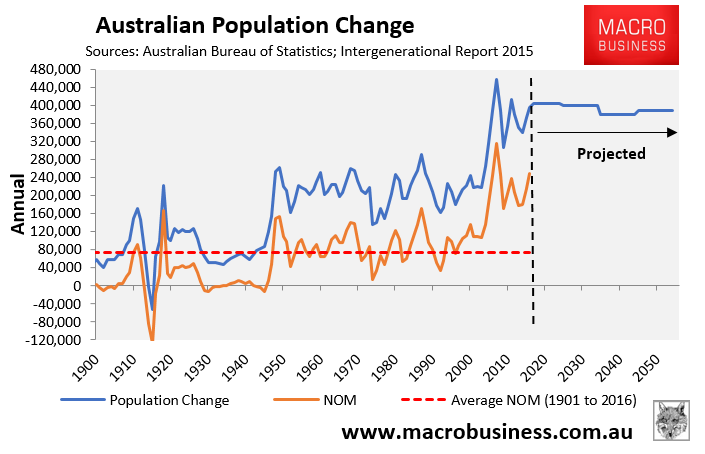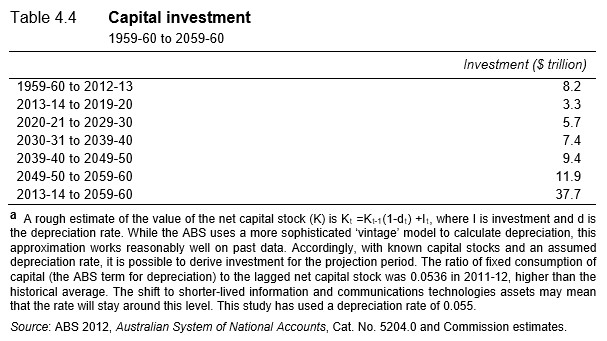
In the wake of the ABS’ population data for the 2016-17 financial year, which revealed that Melbourne’s population increased by an insane 250,000 over just two years and by 1.2 million people in just 13 years (see above chart), Fairfax’s Clay Lucas has attacked successive Victorian governments for failing to provide the infrastructure and services necessary to keep up with this explosive population growth:
Melbourne is a city on steroids: the pace of growth it is experiencing is like nothing in our history…
And yet successive state governments have sat on their hands on public transport expansion and infrastructure investment in the outer suburbs, while watching the land taxes and developer contributions roll in from places such as Cranbourne East and Wyndham.
No wonder two state governments were voted out in that decade, in part over their failures to deliver decent services to voters in marginal electorates…
[The State Government] could do so much more, on suburban arterial roads but particularly on public transport, where virtually everything but big signature projects such as the rail tunnel are put in the too-hard basket.
And that’s just roads and rail. Demand for new schools, health services and other essential public utilities has long outstripped supply.
With growth figures booming as they are and treasury drowning in takings from property taxes, it’s easy for the state government to insist everything is rolling along well…
For seven years now, Melbourne has won the title of the world’s most liveable city – each year causing the city’s citizens to ask the obvious question: liveable for whom?
While Lucas’ frustrations are well justified, he is venting at the wrong target. He should be attacking the federal government.
First, it is the federal government that sets Australia’s immigration policy and is responsible for the hyper population growth experienced in Melbourne (1.2 million) and Sydney (950,000) over the past 13 years:


Of course, the federal government loves this mass immigration program because it collects 82% of Australia’s tax revenue, therefore it receives the lion’s share of the financial benefits that come with immigration, such as increased personal and company taxes.
However, the states and territories collect only 15% of total tax revenue, but must pick up the lion’s share of costs assocated with mass immigration. These include basic things like roads, public transport, schools, hospitals and prisons, which all fall under the states’ responsibility.
Accordingly, investments in these areas always lag due to insufficient funds, with the states also having to resort to tricks like asset sales (privatisations) and user-pays to help pay for additional infrastructure, which inevitably raises costs for existing residents.
Clay Lucas also failed to mention that boosting infrastructure in fast growing cities like Melbourne and Sydney is inherently difficult and expensive due to ‘diseconomies of scale’.
The reason is simple: in already built-out cities like Sydney and Melbourne, the cost of retrofitting new infrastructure to accommodate greater population densities is prohibitively expensive because of the need for land buy-backs, tunnelling, as well as disruptions to existing infrastructure.
Indeed, a 2013 report by the Productivity Commission (PC) warned that total private and public investment requirements over the next half century are estimated to be more than 5-times the cumulative investment made over the last half century:

The PC’s 2016 Migrant Intake into Australia report explicitly noted that infrastructure will have to increase to accommodate a bigger population, and that this infrastructure will necessarily be expensive:
Physical constraints in major cities make the costs of expanding infrastructure more expensive, so even if a user-pays model is adopted, a higher population is very likely to impose a higher cost of living for people already residing in these major cities.
…governments have not demonstrated a high degree of competence in infrastructure planning and investment. Funding will inevitably be borne by the Australian community either through user-pays fees or general taxation…
Whereas, the PC’s recent Shifting the Dial: 5 year productivity review explicitly noted that infrastructure costs will inevitably balloon due to our cities’ rapidly growing populations:
Growing populations will place pressure on already strained transport systems… Yet available choices for new investments are constrained by the increasingly limited availability of unutilised land. Costs of new transport structures have risen accordingly, with new developments (for example WestConnex) requiring land reclamation, costly compensation arrangements, or otherwise more expensive alternatives (such as tunnels).
In a similar vein, The Australian’s Henry Ergas earlier this month argued that these dis-economies of scale in infrastructure are the primary reason for why immigration has become so unpopular:
At its heart, that conflict [over immigration] centres on the resources that are difficult to expand, such as roads in densely populated areas. By increasing the demands placed on those resources, immigration makes them more congested, harming existing users in ways that conventional measures of GDP do not capture…
And the costlier it is to increase those assets’ capacity, the more dramatic the harm to existing users must be as population rises, and demand with it.
That is important because the costs of adapting our major cities to absorb fast population growth are now extremely high.
Clearly, it is the federal government that carries the primary blame for Melbourne’s (and Sydney’s) infrastructure woes arising from rapid population growth.
As long as it continues to maintain a mass immigration ‘Big Australia’ policy, then the federal government must fund the required infrastructure and services. And if it does not wish to provide such funding, then it must dramatically cut immigration.
But maintaining the status quo is untenable and a guaranteed recipe for destroying Australian living standards.

